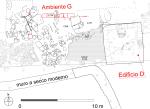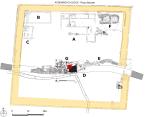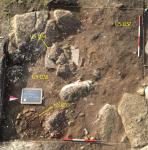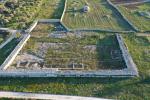Summary (English)
Excavations took place in the locality of Pozzo Seccato where research undertaken from 1997 onwards by the University of Salento has revealed the presence of a fortified farm. The structure, built in the late 4th century B.C., had a quadrangular plan (72 × 65 m) and was occupied until the mid-1st century A.D. (Fig, 1). Excavations were carried out in the settlement’s central sector, an area west of the look-out tower (D) and south of the granary (B), in the area of the stable©, and of the complex with tower that had residential and production functions (A) (Fig. 2). In this area, in 2017, a rectangular room was identified (G9 (Fig. 3), on an east-west alignment. Part of the north wall was uncovered, made of squared limestone blocks (US 1219), together with the cuts in the bed-rock for housing the west wall (US 1220). About 3 m south-west of the wall (US 1219), there was a beaten surface of whiteish crushed tufa (US 1212), covering an area of 5 × 5 m.
Inside room G an area of 2.5 × 2.5 m was excavated, positioned at one metre south of wall US 1219 and characterised by rock outcrops at the centre and north-east and south-west corners (Fig. 4). In the northern half of the trench, a layer (US 1216), identified in 2017, containing abundant pottery – plain ware, banded ware and cooking ware, was removed. Below was a layer of greyish soil with concentrations of baked-clay (US 1237) constituting the remains of a hearth. The removal of the crushed tufa surface (US 1212) revealed: a) an arrangement of flat stones (US 1234) positioned so as to fill the gaps between the outcrops at the centre and south-west corner of the trench and level up the surface; b) at the south-east corner of the trench a layer of compact soil (US 1236) containing tile and pottery fragments similar to US 1216. The removal of US 1236 exposed a circular baked-clay structure, identified as a hearth (US1235). The layer of brown soil (US 1238) in contact with the hearth (US 1235) can be identified as an occupation layer.
The aim of the 2018 excavations was to clarify the function of room G. The first intervention took place outside the room in an area measuring 3 × 4 m, west of the cuts in the bed-rock (US 1220). The first task involved the removal of a layer of gravel relating to the make-up of the asphalt road that until 2008 crossed the site. This revealed an accumulation of dark brown soil mixed with pottery and brick fragments (US 1232). A dark soil (US 1230) containing impasto pottery, dating to the proto-historic phases of the site, was present in the vicinity if the bed-rock (US 1220) outcrops.
- Katia Mannino - Università del Salento, Dipartimento di Beni Culturali
Director
- Katia Mannino - Università del Salento, Dipartimento di Beni Culturali
Team
- Laura Masiello
- Amedeo Galati, Alessandro Rizzo, Marco Calò: archeologi; Angela Masciandaro e Dalila Trani- Università del Salento
- Corrado Notario - Università del Salento, Dipartimento di Beni Culturali
- Katia Mannino - Università del Salento, Dipartimento di Beni Culturali
Research Body
- Università del Salento, Dipartimento di Beni Culturali






![Download [PDF]](/excavation/skins/fasti/images/results/download_sml.png)


